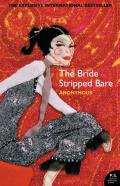4. Momentum
Telling a good story is the bottom line for a genre writer. If you can’t keep the reader turning the pages, you’re nowhere.
Narrative momentum comes down to two basic urges: the urge to find out what will happen next, and the urge to find out what has happened in the past. The writer creates a lean towards further event or towards the solution of a mystery.
A mystery requires a gap in the present state of affairs. Why is Alan acting in this inexplicable way? Why does N’Drath deliberately avoid speaking to Kellon? There must have been a cause—what was it?
The lean towards what-will-happen-next isn’t so different. It’s true, the reader may simply read on for more of the same. In Nikki Gemmell’s The Bride Stripped Bare, the sex scenes we’ve already read lead us to expect more sex scenes to come. But the kind of lean I’m thinking about is the lean you get when you’re waiting for a sex scene that hasn’t even happened. Not more of the same but something different. the sex scenes we’ve already read lead us to expect more sex scenes to come. But the kind of lean I’m thinking about is the lean you get when you’re waiting for a sex scene that hasn’t even happened. Not more of the same but something different.
People who look down their noses at ‘mere’ story (yes, you know who you are, you literary types!) think of story as linear, one event following another, like a string of sex scenes. No! A hundred times no! Story is the unfolding of one event out of another.
A present situation in a novel should be a vector, an arrow towards the future. A respectable relationship between two people now may hold promise of a passionate relationship to come. We interpret the implications, we foresee developments.
Here’s a thought-experiment. If you’re in the middle of reading a novel, put it aside and imagine that the remaining pages have been obliterated forever … then consider all the potentialities. If A does this, then B will do that; if B does that, it’ll push C over the edge; or if B does something else, then D and E will find out; if D and E find out, they’ll turn on F… etc etc. Nothing’s happening, yet everything’s ready to happen.
Is it a story? Maybe only half a story, with the element of ongoing time removed. Yet the other element of story is still there—the element of causal interdependence.
Often, our expectations are indefinite. The sex-and-romance situation I just sketched suggests a fairly specific outcome, but with many situations we could hardly predict developments in the future. We only know that the present situation is unstable and something has to happen.
If you think of story as a line of one event after another, then reading a story will seem a very passive experience. Readers simply lie back and let events roll over them. That’s the view of the anti-narrative literary types. But, if I’m right, then reading a story involves interpreting, questioning, looking ahead. Good exercise for adult minds, good training for kids—any story is good!
But that’s an argument for another day …
|





